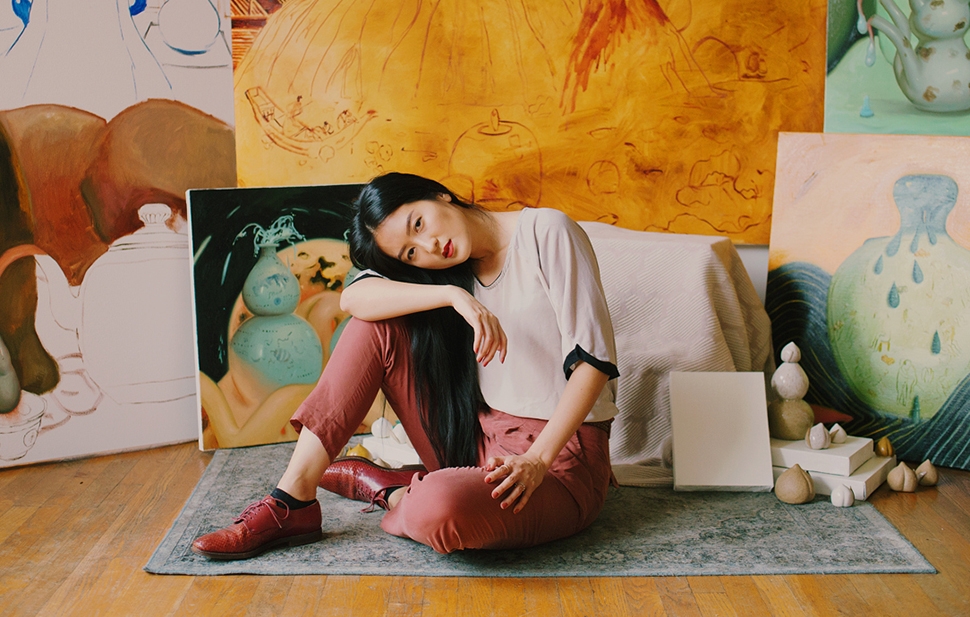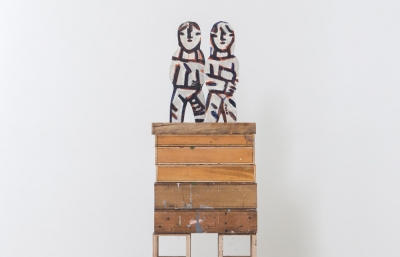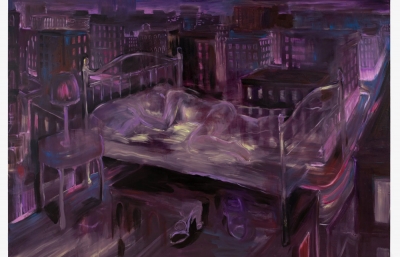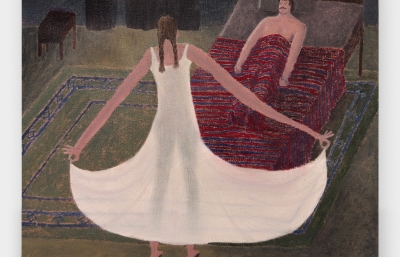Dominique Fung
The Weight of Water
Interview by Jessica Ross and portrait by Mary Kang
Western art history, as a whole, can be an unreliable vision. For centuries, European painters have heralded systems of imperialism through their works and, for the average art viewer, it’s difficult to untangle colonial context while perusing the halls of a major museum. Western depictions of the East are littered with tropes of the exotic, the fetishized and the voyeuristic. Painters like Delacroix, Jéan Léon Gérôme, and Rousseau have shaped a binary view of the world with patronizing depictions of snake charmers, geishas and bathhouses. Second generation Chinese-Canadian painter Dominique Fung collects these problematic notions and recasts them through her own lens, refiguring art history to give her subjects real agency.
Her work is luscious, refined and inviting. Warmly lit, melodically composed and exuding sensual energy, Fung’s paintings don’t appear critical at first glance, but upon closer inspection, her subjects protest, laugh and make absurd gestures, posturing themselves politically in Fung’s world. By subverting the narrative and utilizing the imagery of Western art history’s own design, Fung is able to present a more genuine view of identity, one unique to her own personal history and shared experience.
I sat down with the Brooklyn-based painter this summer to chat about her creative upbringing in Ottawa, the theoretical writings that have influenced her work, and what it means to create a new narrative with paint, one stroke at a time.

Jessica Ross: Your paintings are warm and inviting. They draw you in with sensuous tones and glossy finish. Do you think this polished aesthetic allows exploration of less gentle themes in your work under a welcoming veneer?
Dominique Fung: I definitely use sensuous tones and glossy finishes but also humour and the uncanny as a mechanism to draw the viewer into the painting. Perhaps a similar correlation between welcoming veneers is stand-up comedy, which I’m a big fan of. Good stand-up allows for several layers of ideas through a seemingly funny or strange narrative, but often has a complex and serious undertone. Stand-up comedy gives the illusion of dialogue when, in reality, it’s a monologue. I think about this a lot and I can very much relate to this.
Who are your top three?
My current favorites are Ali Wong, Dave Chappelle and Trevor Noah.
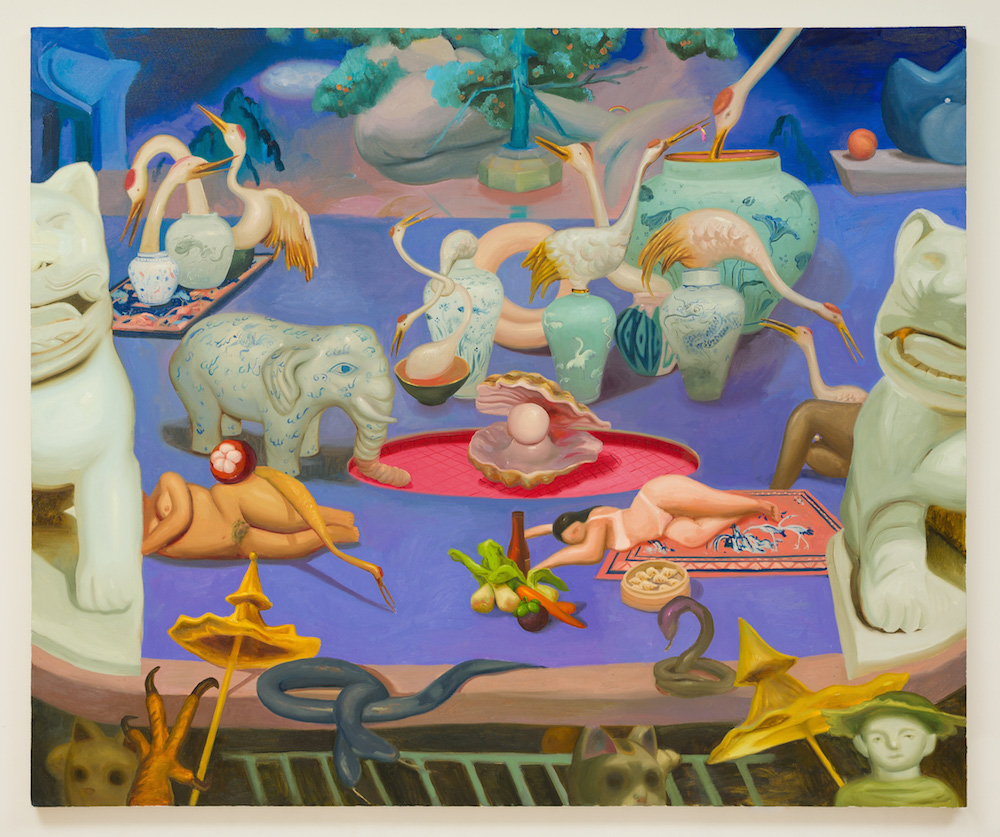
You utilize a plethora of imagery to subvert Western interpretations of the East through the lens of traditional European painting. What are some of the meanings behind the figures and objects in your work?
I’ve used imagery of lounging nude women similar to women depicted in nineteenth-century European and Orientalist paintings in my latest body of work. The figures, bodies and objects in my paintings carry visible weight and take up space when often, in society, East Asian women’s bodies are barred from sexuality and taking up space, painted or physical.
I think we are all on board with the problematic depictions of women and people of color in historical European paintings. Instead of using a completely different language to move away from it, I’m interested in using it to negotiate with the past.
There’s a beautiful quote by Edward Said in Orientalism, “My argument is that history is made by men and women, just as it can also be unmade and rewritten, always with various silence and elisions, always with shapes imposed and disfigurements tolerated.”
I want to liberate these figures and objects, to give them a narrative through repetition over several paintings. These artifacts, vessels and sculptures are animate protagonists in my paintings, whereas historically, these objects have been seen as cultural tropes.
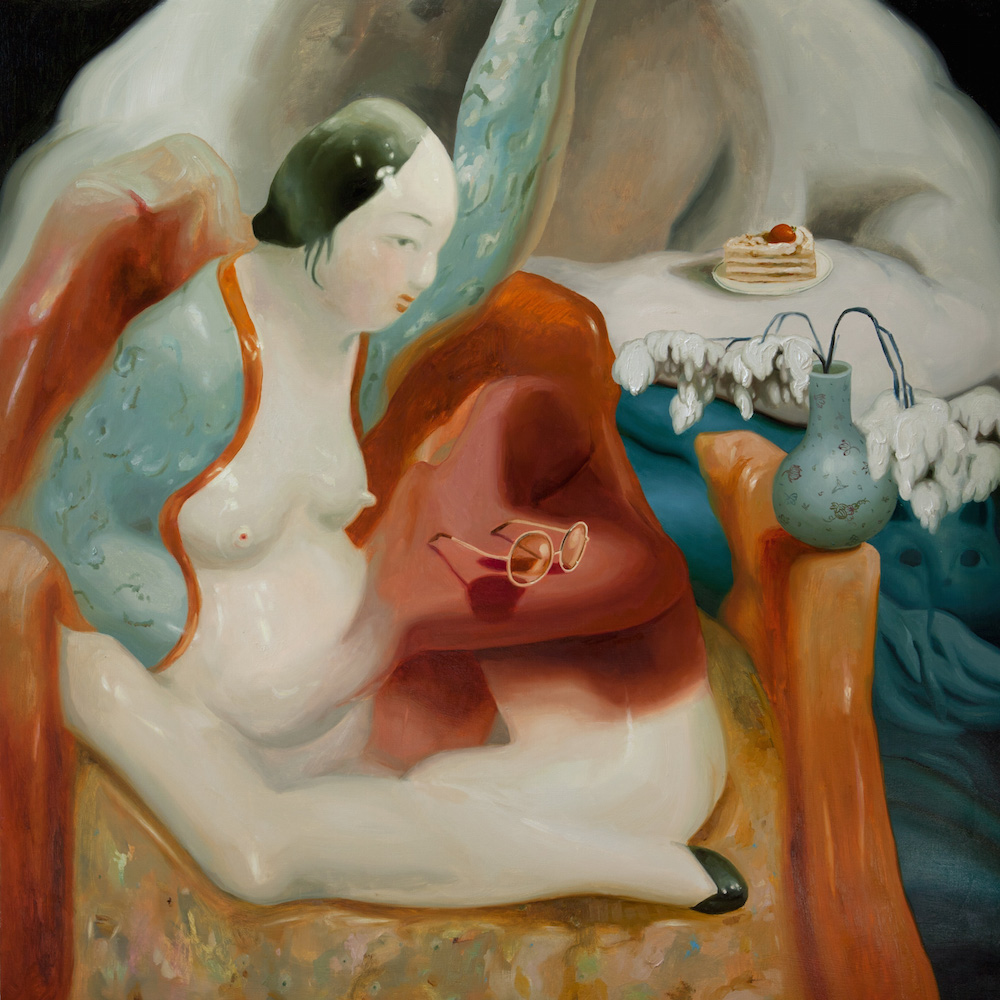
We’ve talked about the “orientalism and ornamentalism” of Asian subjects, specifically Asian women. How do your still lifes act as vehicles for the discussions around fetishization and exoticism in your work?
My artistic practice isn’t rooted heavily in theory, though reading theoretical writing has helped me understand some of the intuitive decisions I’ve been making in my paintings. Ornamentalism by Anne Anlin Cheng has been instrumental in helping me clarify ideas or feelings I already have while making work in my studio. I feel her words are better at describing what I’m trying to grasp at through painting, which she describes in these words:
“Orientalism is a critique, ornamentalism a theory of being. The latter, for me, names the peri humanity of Asiatic femininity, a particular state of being produced out of the fusion between ‘thingliness’ and ‘personness.’ As such, ornamentalism often describes a condition of subjective coercion, reduction, and discipline, but it can also provoke considerations of alternative modes of being and of action for the subjects who have not been considered subjects, or subjects who have come to know themselves through objects.
“Culturally encrusted by representations, abstracted and reified, the yellow woman is persistently sexualized yet barred from sexuality, simultaneously made and unmade by the aesthetic project. Like the proverbial Ming vase, she is at once ethereal and base, an object of value and a hackneyed trope.”
Some of the objects I paint are vehicles to discuss fetishism, exoticism and othering, similar in the way Anne Anlin Cheng describes subjects who have not been considered subjects. Others are to reclaim objects that may have been made into tropes.
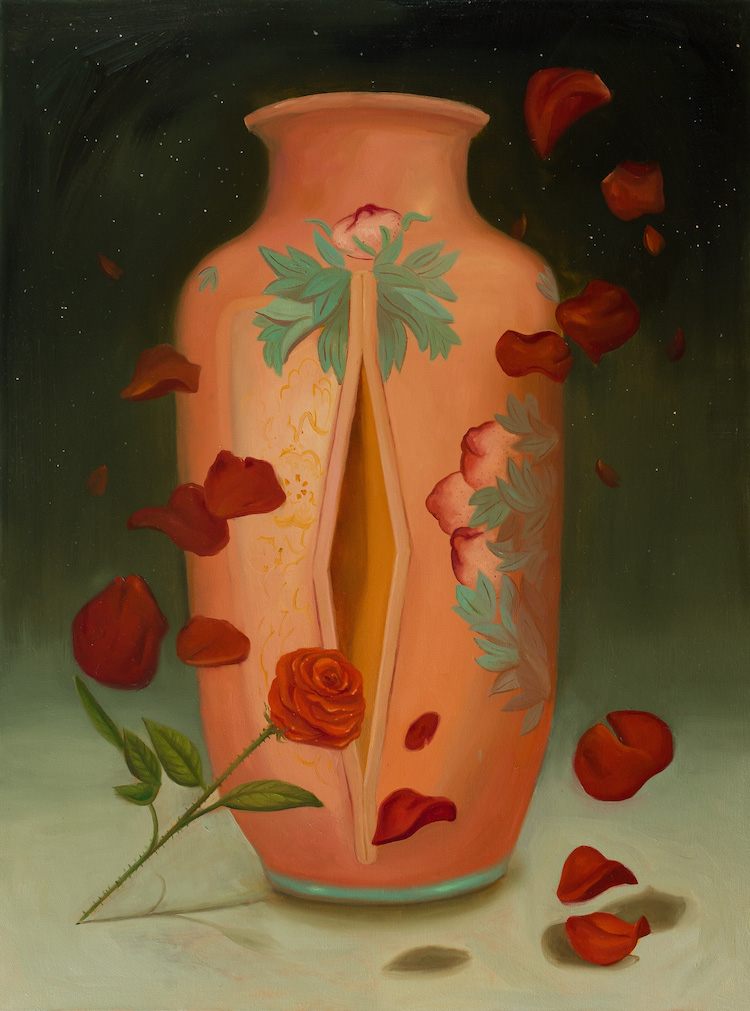
On that note, you’re intentionally trying to blur the lines between figuration and still life in order to converse about orientalism and ornamentalism, right?
Absolutely. Figures have been and still are being used as objects, so then why can’t objects embody history, identity, life and sense of being?
This year, you began dabbling in mediums outside of oil painting, including installation and ceramic work. What challenges and surprises have you come across in these new fields?
At times, I feel that I can’t emote what I want to depict with just painting. In using 3D space and physical objects, I’m able to capture all of the senses and really bring out specific feelings and ideas. I’ve realized there is a lot that can go wrong with installation work and ceramic, and the variables for disaster are unpredictable. Experimenting with new materials is always stressful but also exciting. I’m still figuring out the best way to incorporate all these new mediums into my practice, but for now, I’m going to just make a bunch of work and eventually it’ll make sense to me, conceptually.
What is the importance of water in your work? It comes in many forms via fountains, baths and pools. Can you elaborate on its significance?
It’s a feeling or sensation I’m grasping for. Water may not actually be water and rather, a presence in my paintings. The presence could be stillness, energetic, flowing, contained, explosive, calming, an observer or something to be observed. As I try to explain the sensation I’m trying to achieve with paint, my words often crumble into little pieces.
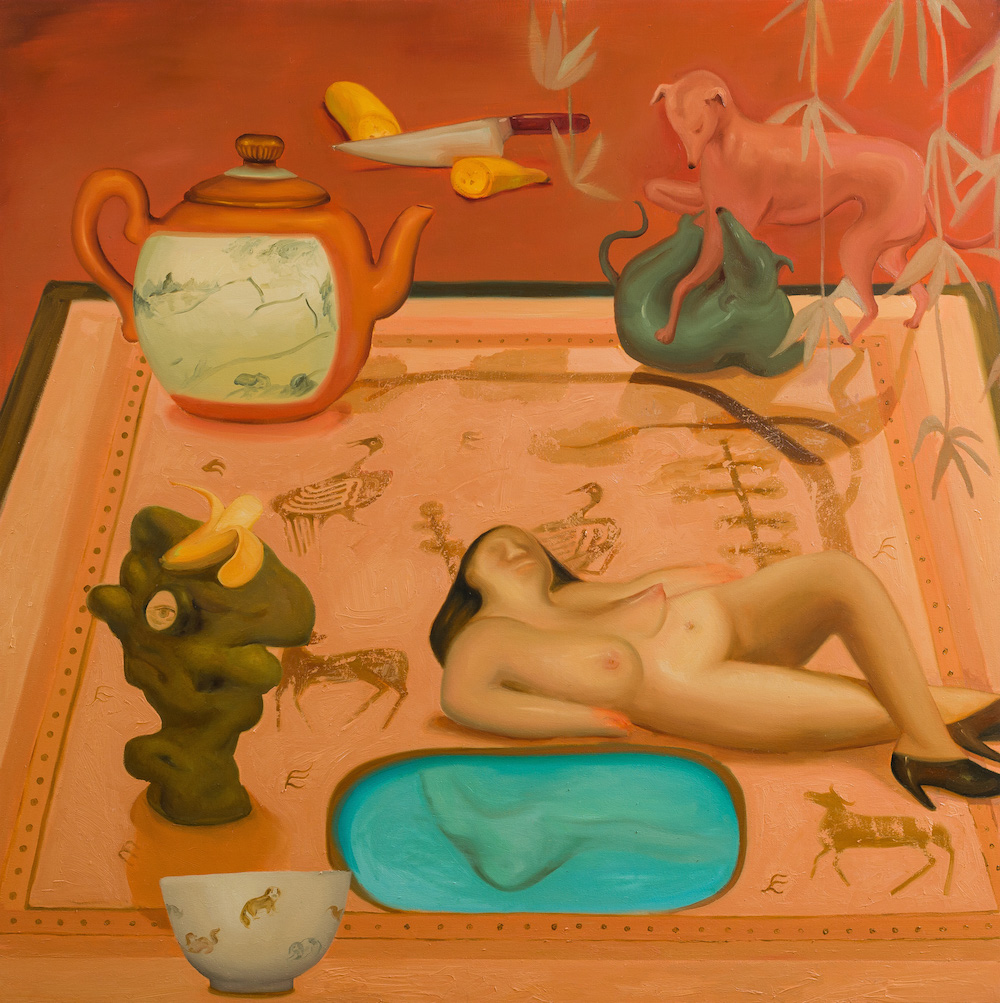
Why bathhouses? Can you elaborate on their importance in your work?
I have a love for Japanese woodblock prints and specifically bathhouse prints. They evoke community, contained in a safe space where you are able to care for yourself, your children or others. Bathhouses, unlike spas, are community-based and generally, anyone from any socioeconomic background has access to them. It is freeing not to be judged, to be in a room with many other people naked, people of all ages and sizes performing the simple task of self-care.
The bathhouse, as an image, has been widely used to dehumanize women and POC in paintings, as well as in film, and I wanted to take some time to point this out through several paintings and create discourse and a new narrative.
“As I try to explain the sensation I’m trying to achieve with paint, my words often crumble into little pieces.”

Any in-studio rituals you’d like to share? What do you listen to while you paint?
I’m pretty sure I have a mild case of OCD. My studio needs to be fairly tidy and I spend approximately 30-plus minutes cleaning up before I can begin my day. I need three or four beverages by my side table at all times: coffee, tea, water, some sort of green juice, as well as wine, beer in the evening to balance out the healthy.
I’ve had lung and health problems in the past from the overuse of mineral spirits, cobalt driers and alkyd mediums. I have three purifiers running and I make sure the settings are higher while I paint. Paintbrushes need to be washed in the evening and palette completely scrapped. If I have a good amount of unused paint, I wrap it up with plastic wrap every day.
The Rolodex of what I listen to in the studio changes often due to the fact I work best with long, uninterrupted studio hours. I have to rotate through an abundant amount of content, otherwise it becomes too repetitive in the studio. Spotify is amazing. It takes away the time I need to search for music, and I usually will play anything from top 50, rap, Broadway musicals, to ’90s canto music, kpop, jpop, movie soundtracks, classical music and EDM. The only music I can’t seem to get into is metal. I’ve finished several serial murder podcasts and now I’ve been listening to comedic podcasts and audiobooks.

When did you first become interested in oil painting? There is a clear thread to French Naturalism and Rococo style in your work. Do you remember your first encounter with this genre?
I was first introduced to oil painting when I was around 10 years old at an art class I was taking, and it wasn’t until I attended a fine arts high school that I became more serious about painting. I was seduced by Baroque, Dutch and Flemish Renaissance paintings, as well as the Rococo style of works early on, partially because this was all I had access to through textbooks. There wasn’t a lot of access to contemporary art in Ottawa and even in Toronto when I first moved there.
I was less interested in Baroque and Rococo ideas, but rather wanted to learn how to describe the figure-ground from a technical point of view and to use some of these techniques to draw a viewer into a picture plane.
Since then, I’ve gone back to Surrealism, which was what I loved from the moment I found my first Salvador Dalí and Frida Kahlo painting when I was 10. I’ve recently mostly been looking at Surrealist and Impressionistic works by Honoré Sharrer, Dorothea Tanning, San Yu and Leonora Carrington, to name a few.

What is the number one thing you learned from traditional European oil painting that you want to keep in your arsenal?
Traditional European oil paintings have taught me to use lighting and drama to direct the viewer's eye to specific parts of the painting. This is applicable to sculpture and any type of installation works I plan to do in the future.
I notice you’ve created some unique objects that end up as subjects in your paintings since your experimentation with ceramics. Which came first? The need to paint something in real life, or the need to sculpt something from your own paintings?
Currently, I’ve been sculpting objects that make their way back into the paintings. I usually reference objects from auction sites, eBay sites, museums and outdoor sculptures. I then paint them and manipulate them on the canvas. My sculptures exist in the paintings already, but I’ve been experimenting with new sculpted 3D

You like to play with size and scale, often blowing up objects in your work or creating impossible, surreal environments. How do you make illusion work in your favor in your paintings?
I’m interested in the uncanny and certain Surrealist ideas by creating these impossible scenes that allow for freedom from the binary. My paintings aren’t this or that because I’ll change up the illusion once you think it’s this one idea.
Clearly, we have a long way to go in terms of inclusion in media, and specifically, art institutions. Which galleries and museums do you think are doing a good job at the moment?
The New Museum, in my opinion, is one of the most exciting institutions right now. They are consecutively putting on incredible exhibitions, pushing boundaries and are fearless in their curation. I see they are showing a wide range of thought-provoking work by marginalized artists, and that gives me hope.
I also think the Brooklyn Museum is moving in the right direction, and though they are not perfect, by removing the cost of entrance, they allow more people to view the work. They just had two great shows with Liz Johnson Artur and Frida Kahlo. I’m really looking forward to Kehinde Wiley’s show in the new year.
Dominique Fung will have her first Los Angeles solo exhibition with Nicodim Gallery in Spring 2020.

